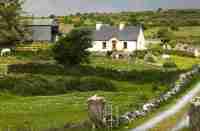Property prices in Roscommon have risen by €13,000 during the first quarter of 2024, according to the latest MyHome.ie Property Price Report.
The report for Q1 2024, in association with Bank of Ireland, shows that the median asking price for a property in the county is now €180,000. This means prices have risen by €11,000 compared with this time last year.
Asking prices for a three-bedroomed, semi-detached house in the county rose by €5,000 over the quarter to €157,500. This means prices have risen by €7,500 compared to this time last year.
Meanwhile, the asking price for a four-bedroomed, semi-detached house in Roscommon fell by €30,500 over the quarter to €169,500. This price is up by €10,000 compared to this time last year.
There were 153 properties for sale in Roscommon at the end of Q1 2024 – this figure has not changed since Q4 2023. The average time for a property to go ‘sale agreed’ in the county after being placed up for sale now stands at nearly three months.
In terms of the national picture, the author of the report, Conall MacCoille (Chief Economist at Bank of Ireland), said, “The message from this quarter’s MyHome.ie report is that the housing market is heating up again. MyHome asking prices rose by a solid 2% in the first quarter, with the annual inflation rate accelerating to 6.5%, its fastest pace in 18 months. Notably, Dublin – where valuations had become most stretched during the pandemic – is joining in the rebound, with annual asking price inflation of 7.2%.
“We can see that demand is particularly intense from transactional activity. The number of homebuyers (first-time-buyers and movers) rose to 44,100 in 2023, up 1.4% on 2022 and accounting for 71% of total transactions. This is the highest proportion of transactions accounted for by homebuyers since 2013. In contrast, household buy-to-let purchases fell by 9% in 2023, no doubt hurt by higher interest rates.
“It is also significant that the number of non-household transactions fell by 6.6%, to 12,300. Of late, the role of the State in purchasing homes has received much attention. However, the fact that total non-household purchases fell so sharply in 2023 must also reflect reduced demand from institutional investors in the private rented sector”.





